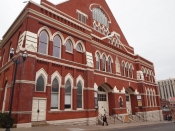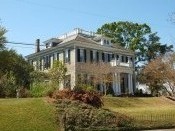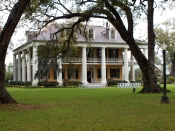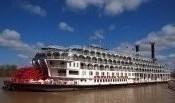We have a Frommer’s Guide to New Orleans dated 1996, which indicates just how long ago we first showed an interest in visiting the city. So when we spotted a trip down the Mississippi that finished in the ‘Big Easy’, it was too good an opportunity to pass up. Especially as it took place on a beautiful paddle steamer river boat and visited a number of other southern state towns and cities, famous for both their civil war heritage and blues, soul, country and jazz music pedigrees. What’s not to like. We could never be accused of being tardy, it only took us 17 years to get round to it. And yes, we did still use the Frommer’s Guide.
Here are a few highlights….and in the spirit of the Simpsons’ “comic man” – longest post ever!…..

Nashville
Flew into Nashville and spent a couple of nights there. Managed to squeeze in a visit to the Country Music Hall of Fame and Museum and on the second night a trip to the Grand Ole Opry. The latter was as cheesy as you might expect but still terrific fun. The country audience certainly stays with its stars once it’s made the connection – Alan Jackson could probably have got way with a rendition of ‘Keep The Red Flag Flying’, even in the Republican heartland! The radio show still showcased some young talent however and Chris Janson is definitely one to look out for. Also squeezed in an afternoon beer at a downtown honky tonk– both local beer and live music better than anticipated. Special mention to the Gaylord Opryhotel – not so much a hotel as a way of life and the perfect embodiment of American excess; internal gardens, replete with waterfalls larger than some town parks. At the night we were at the Opry, Clapton was playing the Bridgestone arena in the country music capital.

Memphis
Only managed an overnight stay here. Went to the ‘must see for the music buff’ Sun Studios. Despite all that you’ve read (the histories, the biographies etc.), still nothing prepares you for just how tiny the recording studio really is. Recordings that fundamentally changed the course of popular music emanated from a very small and somewhat basic lower ground recording room and booth – talent, drive and ambition certainly beat the odds in the early days of rock’n’roll. Dinner at B.B. King’s Blues Club (properly raucous, not to everyone’s taste I guess). Stayed at the histroic Peabody – glad we did, glimpsed the ducks but hotel definitely living on past glories. The following morning made the obligatory trip to Graceland. I was a little dubious about going and it was more than a touch formulaic, but still worthy of a visit. Graceland itself much smaller than anticipated. Didn’t get time for the Stax Museum, which was real regret. Then on to the American Queen Steamboat.

Helena
A once prosperous town that had clearly declined badly over the last thirty years or so, with the population dwindling dramatically over the past two decades. Locals were however justifiably proud of the regeneration that was taking place, some of it based around the town’s central role in the civil war. The Battle of Helena was, for the size of the forces engaged (nearly 12,000), as desperate a fight as any in the Civil War but was somewhat overshadowed by the fact that Vicksburg fell the same day. A few of the grand ante-bellum houses were still extant, including the Historic Pillow Thompson Home and the Moore-Hornor home (1859), which remained standing as the Battle of Helena took place all around it. The latter home is a great example of sympathetic restoration within limited funds. One hopes the resident population, Delta Cultural Centre and regional government bodies succeed with the regeneration plans, because it was clear that there were areas of real poverty and deprivation. Helena is also the home of the wonderful King Biscuit Blues Festival (and radio show), which will hopefully continue to bring some much needed trade into the town.

Vicksburg
Another famous Civil War location, the town has fared far better than Helena in the years following. Full of history, highlights for us included the Old Court House Museum (1858), which survived the Civil War with minimal damage, the River Museum and the Biedenharn Candy Museum (I kid you not), where Coca-Cola was bottled for the first time in 1894 – not historically riveting I grant you but then again if you happen to be in Vicksburg! The Church of the Holy Trinity is on the National Register of Historic Places and houses some far from shabby Tiffany stained glass windows. Lots of ante-bellum architectural gems also to be seen as we walked the city. Only had time to drop in on the Visitor Centre of the National Military Park, but it was worth it for the twenty minute film that overviewed the Vicksburg civil war campaign – perfect for newbies such as us.

Natchez
In the morning we went to the ante-bellum home of executive chef for the American Queen Regina Charboneau – lovely warm welcome from the lady herself and great to see a homely, lived in house not weighed down by the lofty pretensions of its history. Natchez itself is one of the oldest and most important European settlements in the lower Mississippi river valley, and served as the capital of the Mississippi Territory and then the state of Mississippi (before Jackson). It largely survived the Civil War intact and is full of well restored ante-bellum mansions. Magnolia Hall and Rosalie were particularly impressive, as was Stanton Hall, built by an Irish immigrant Frederick Stanton (it seems a good number of Irish made their way South from the northern cities and made their fortune in the cotton trade). A favourite in Natchez however was the story of William Johnson a “free man of colour” but who was originally born into slavery. When freed, he became a barber and acquired several properties, including the family home. He was a freed slave who himself ‘owned’ slaves. He was killed in a land dispute in 1851. His murderer was held in prison for two years and brought to trial twice; but was freed because he claimed to be white (he wasn’t) and the only witness to the murder was a black man, who under Mississippi law at that time could not testify against a white man. It was never simple in the South!

St. Francisville
It’s finally warmed up – shirtsleeves at last. The second oldest incorporated town in Louisiana had an inauspicious start as a burial ground. It has over 140 buildings on the National Register and I supsect we looked at most of them that were in central area. (Excellent walking tour and map from the museum). In fact, the historic downtown of St. Francisville is recognized on the Register of Historic Significant Sites. On our visit, a film crew for a TV production of Bonnie and Clyde was just wrapping up and had taken over the two coffee shops; gutted, as I was desperate for a decent coffee! The town was very sleepy (the harsher visitor might suggest lifeless) but for me it was a solid representation of my predetermined and idealised notion of a quiet southern town on the banks of the Mississippi. And if you’re interested, a two bedroomed Blue Cottage with open floorplan is yours for $285,000. 🙂

Baton Rouge
How many assumed New Orleans was the Louisiana state capital – no, just me then! Louisiana’s capital, home of the legendary and controversial Huey P. Long, is one of the South’s fastest growing cities – sadly, Katrina had a significant part to play in the recent expansion. Far more to do than one day would allow, we concentrated on the Old Governor’s Mansion, replete with Huey’s ‘as was’ office, the magnificent Louisiana State Capitol building and a walk through Downtown to see St. Joseph Cathedral, the 160 year old gothic style of the Old State Capitol building and the Pentagon Barracks, amongst others. In the area renowned for blues, zydeco and cajun music it was a tad ironic that UK institution Elton John was headlining at the River Centre Arena the night we were there – Brisitsh superstars seemed to be following us around!

Houmas House
A plantation strategically located on the banks of the Mississippi (with its own levee), the mansion itself was completed in stages but was finally finished in 1828. It became the hub for sugar empire of more than 300,000 acres. Bought in 1857 by the Irishman (theme developing!) John Burnside, who went on to become the country’s biggest sugar producer. In the Civil War, he claimed immunity as a British citizen, which probably saved it from being burned to the ground by the Union forces. Now beautifully restored (it fell into decline post 1927 depression), it’s hard not to admire its grandeur whilst at the same time acknowledging the significant injustices of the social and economic system upon which it was built. It was one to see, a genuine plantation home and an insightful reminder of another era. Can’t belive we forgot to go in the Turtle Bar and have a mint julep, which is one of the very many places that lays claim to its creation.

New Orleans
Arrived in the Big Easy, quick orientation tour and a visit to the National World War 2 Museum – interesting and broad in scope (with an American bias, obviously), not sure we’d have bothered if we hadn’t booked the extra nights in the city and knew we could explore in more depth over the next two days. Dinner at Tujagues, a New Orleans institution and the second oldest restaurant in the city – Creole cuisine, including a very spicy Gumbo (even for me) and their signature boiled beef brisket with horseradish sauce. Special mention to the Hotel Monteleone, where we stayed for three nights. Great room with view of the river, friendly service, excellent food – the New Orleans Crawfish Etoufee was fantastic, which is something that I never thought I’d write, especially as I wasn’t even aware of the term (crayfish, apparently). On our second day, we undertook a walking tour of the French Quarter, using the self same 1996 Frommer’s Guide! The Quarter didn’t disappoint, finished the afternoon in the French Market at the Gazebo Cafe for an ice cream daiquiri, Po’ Boy and some live blues from Les Getrex and band. Evening spent at Pat O’Brien’s where we indulged in the famous Hurricane cocktail (rum, some rum and a bit more rum and a token droplet of fruit juice). Second day, more wandering and a ‘has to be done’ ride on the St. Charles line streetcar, followed by a look at some of the many mansions and ante-bellum homes in the upmarket Garden district. Walked to the above ground St. Louis Cemetery No. 1 at the corner of St. Louis and Basin Streets. Opened in 1789, it’s the oldest and most famous of the City of the Dead St. Louis Cemeteries in New Orleans. Some vaults are newly renovated, some are in disrepair, all fascinating. A stroll around Armstrong Park which incorporates Congo Square (given its history, probably the heart of the origins of jazz) and another beer and the day was over. Excellent dinner at the aforementioned Monteleone and our time was up! BTW, we never felt at risk anywhere in the city. Just be sensible, no different from any other major city.

The Steamboat
The American Queen is apparently the biggest steamboat ever built. It is a truly magnificent boat and when sailing on it down the Mississippi something definitely just feels right about the world. It’s also amazing that a boat of this size can simply pull up against a sandy bank, nestle in the mud and moor. Just watching the boat operate was a pleasure. Lovely public areas and rooms with ample space (where some tense cross Atlantic scrabble sessions took place), pleasant but small cabins and the thrill of watching that ‘big wheel keep on turning‘ all make for a very relaxing way to navigate the lower Mississippi. Service in the dining room was, in all fairness, iffy and the food veered from average to good but the engine room bar was a great place to relax and the Juggernaut Jug Band (you heard me) and New Orleans Jazz All-Stars provided some authentic local entertainment. I would have preferred a genuinely local blues group one night as well (a second rate Blues Brothers tribute band doesn’t cut it) but enjoyable stuff nonetheless. Small, easily made improvements by the management staff would push it to the level to which it aspires. At the moment, the boat clearly outshines its staff. Overall, however, if you want to travel through the Mississippi lower river States, visit some lovely places and get a real feel for the civil war and the struggle to replace the economic and social systems that caused so much damage to the many, whilst admiring the lifestyles of the few, this has got to be the way to do it.
